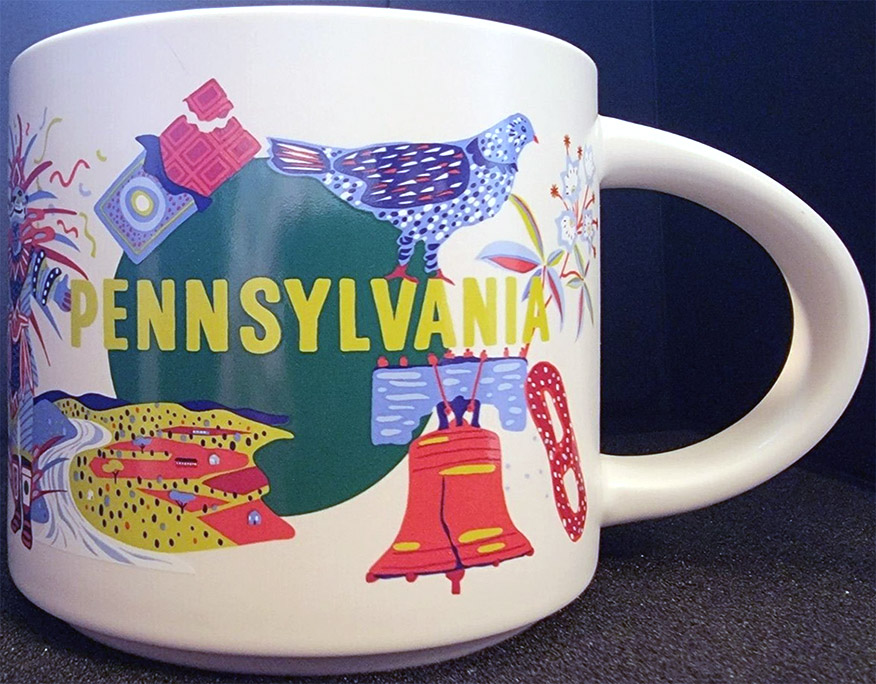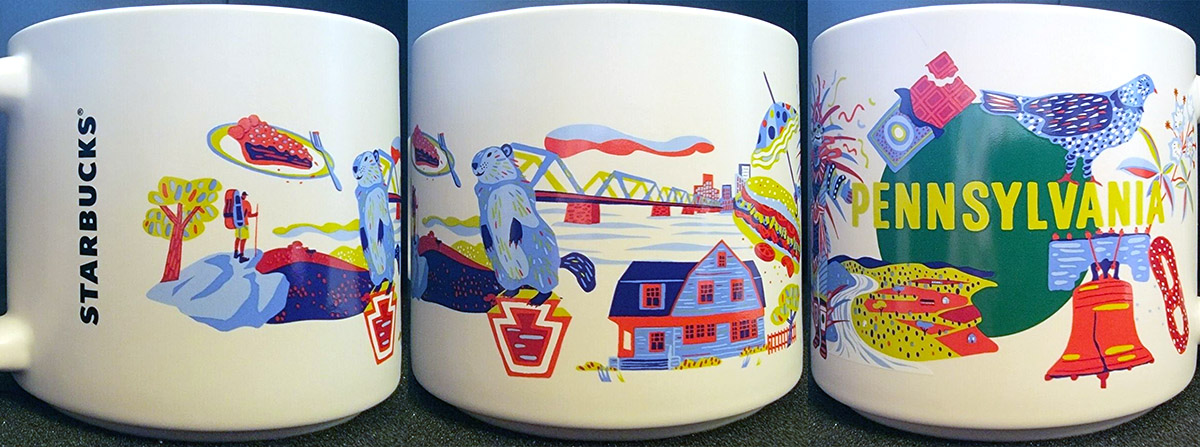
Discovery Series – Pennsylvania
Starbucks Discovery Series – Pennsylvania is a mug for a state in the northeastern US, one of the original thirteen colonies. Its name, meaning “Penn’s Woods,” pays homage to William Penn, the English Quaker who founded the colony in 1681. Penn sought to establish a haven for religious freedom and tolerance, principles that would shape Pennsylvania’s character for centuries to come. In 1776, it played a pivotal role in the American Revolution as the site of the signing of the Declaration of Independence in Philadelphia. Later, the state became a crucible of industrial innovation during the 19th century, fueling America’s growth as a manufacturing powerhouse. Today, Pennsylvania stands as a testament to its storied past, blending historic charm with modern vitality.
Here are some well-known symbols and landmarks of the Keystone State:
– The Liberty Bell, housed in Philadelphia, stands as an enduring symbol of American freedom and independence. Cast in 1752, its iconic crack emerged shortly after its arrival in Pennsylvania and has since become a part of its storied legacy. The inscription “Proclaim Liberty Throughout All the Land Unto All the Inhabitants Thereof” from the Bible (Leviticus 25:10) further cements its role as a beacon of liberty for generations to come.
– The Ruffed Grouse, Pennsylvania’s state bird, is a small game bird known for its stunning plumage and distinctive courtship display. It is often found in the state’s forests and is cherished by hunters and wildlife enthusiasts alike.
– The Mountain Laurel, Pennsylvania’s state flower, blooms in late spring and early summer, adorning the landscape with its delicate pink and white flowers. This beautiful evergreen shrub is a beloved symbol of the state’s natural beauty and can be found in abundance throughout the Appalachian Mountains.
– Gettysburg National Military Park preserves the site of one of the most pivotal battles of the American Civil War. It serves as a memorial and educational center, allowing visitors to learn about the sacrifices and consequences of the conflict.
– The groundhog holds a special significance in Pennsylvania, particularly in relation to the celebration of Groundhog Day. The tradition of using an animal to predict the weather on February 2nd has its roots in ancient European weather lore. When German immigrants settled in Pennsylvania, they brought this tradition with them and replaced the European badger with the groundhog as the weather prognosticator
– Pennsylvania has a sweet connection to chocolate, as it is home to several renowned chocolate manufacturers and a rich history in the confectionery industry. One of the most famous chocolate companies, Hershey’s, established its roots in the town of Hershey in the early 20th century. Milton S. Hershey, the founder, built a chocolate empire that continues to produce delightful treats loved by people worldwide. The scent of melting chocolate wafts through the air in Hershey, where visitors can indulge in chocolate-themed attractions, such as Hersheypark and Hershey’s Chocolate World.
– Shoofly Pie is a traditional dessert hailing from Pennsylvania Dutch country. This delectable treat is made with a rich, molasses-based filling that strikes a perfect balance between sweet and gooey. Its distinctive crumbly and cake-like texture, paired with its deep, caramel-like flavor, makes Shoofly Pie a beloved indulgence that showcases the unique culinary heritage of Pennsylvania.
– The Philly Cheesesteak is an iconic sandwich that has become synonymous with Philadelphia’s culinary scene. This mouthwatering creation features thinly sliced beefsteak, usually ribeye or top round, cooked on a griddle until tender and juicy. The meat is then piled onto a long, crusty roll and topped with melted cheese, typically American or provolone. Optional additions like sautéed onions, sweet or hot peppers, and mushrooms can further enhance the flavor profile.
– The figure to the left of the title of the mug is probably a reference to the Mummers Parade, which is an annual tradition that takes place in Philadelphia on New Year’s Day. This lively and colorful event dates back to the 17th century and showcases the city’s vibrant folk culture. The parade features various groups known as “mummers” who perform elaborate musical numbers, dance routines, and wear elaborate costumes. Each group competes for prizes based on their creativity, craftsmanship, and overall performance.























































































